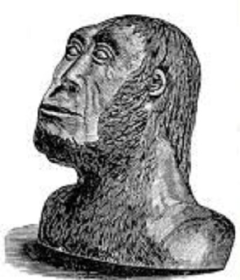The Neanderthal's Advice to a Neurologist
Spring 2018

The Neanderthal's Advice to a Neurologist
The Neanderthals lived for 200,000 years. In the Earth’s history, this is a surprisingly long time. We (Homo sapiens) have lived outside of Africa for only 80,000 years. Archeologists have spent decades with the artifacts of our cousins of the North. They have examined their tools, cave dwellings, their garbage and burial plots, and their bones. Neanderthal bones show patterns of use and fractures that most closely match only certain types of modern human injury, such as rodeo riders. They were physical, hard-living folks with short life spans, but still made insightful artwork and had community relationships and a sense of tribe.
Why did they not make it? Perhaps we beat them out of prime real estate. Maybe we just beat them physically. One thing that gives a clue to their demise lies in their use of tools. The types of tools found in early Neanderthal dwellings were the same as those in the last Neanderthal dwellings: simple cutting edges, spears, blunt hammering objects, and animal hides. Neanderthals did not change. After 200,000 years, they lived much as they did at their beginning. On the other hand, Homo sapiens progressed from tools of cutting edges and hammering rocks to slingshots, arrows, pottery vessels, food utensils, jewelry, and sacred symbols. Homo sapiens constantly changed, grew, adapted, and morphed to their environment and their opportunities. They would soon develop the peanut butter and jelly sandwich.
Neanderthals became extinct because they did not prepare for change. We share 99.7 percent of their genome, yet somehow they did not get the gene set that codes for restless dissatisfaction with the present condition that typifies modern humans. We ended up beating them in the Darwinian foot race because we naturally developed a greater understanding and control of our environment. The one thing that defines modern humans, and our present world, is change. Perhaps this is not just a passive characteristic of the world, but the world that directly results from the ascendency of our species. We are certainly imposing stiff changes on the Earth and on ourselves that will require constant examination of who we are, where we are going, and how we need to change to get there.
With all of their large-mammal bronco-busting simplicity, the Neanderthals tell us how to plan for our futures, our careers, and our neurology departments: Plan for change. Don’t expect that the world in which you train as a young person will be the world in which you will need to make it as a senior faculty member. Pursue the career opportunities that provide the maximum challenge and the most thorough training so that the tools you have at the end of this training will not be the tools that you will develop by your mid-career. Plan for a professional education that will develop your mind; set your expectations and lay down standards for growth.
The mission of the UCLA Department of Neurology is to understand the human nervous system and to improve the lives of people with neurological diseases. This mission requires innovation in the methods to understand neurological disease and in the care of those with these diseases. It demands the constant examination of how we learn about the brain so that we can ask how we can do it better. How can we change and evolve in our approaches in research and in clinical care? In these pages you will find the people who are changing treatments for neurological disease and patient care. In this spring edition of the Chair’s Report we learn how Dr. Charles Flippen, the Richard D. and Ruth P. Walter Chair in Neurology, leads our educational efforts to train young neurologists to adapt to change, to lead neurology to embrace change, and to grow toward the future.
The guy who built the Brooklyn Bridge provides the anti-Neanderthal advice. The Brooklyn Bridge was a marvel of its time, an engineering feat considered impossible before John Roebling actually, well, just got it done. He suffered an incapacitating broken foot. He got the bends (a neurological disease) from going deep underwater in a then-modern diving “box” to supervise the building of the bridge pilings. The bends further incapacitated him and put him in constant pain. When asked later about his accomplishment and his travails Roebling said, “Nothing is easy and nothing does itself: character and action are everything.” If one can fashion one’s life, build a neurology department by adding to character and action the innovation that provides an ability to excel with constant change, then this is the Neanderthals’ lesson for career development, for neurological care and for a neurology department.
Photo courtesy of the Library of Congress/Wikimedia Commons